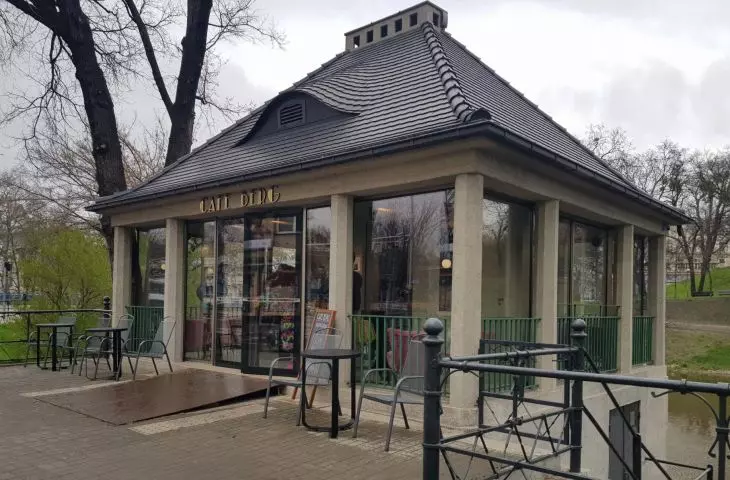Max Berg, an architect active in Wroclaw for many years, went down in the history of the city and in the consciousness of Wroclaw citizens mainly through the design of the monumental Centennial Hall. More than a century since the construction of this iconic edifice began, the city has not forgotten Berg - the urban architect has lived to see a street named after him in Wroclaw's New Żerniki, as well as a small café in the city center - Cafe Berg.
Cafe Berg proves that the architect was not intimidated by any scale of buildings. Berg designed the small, two-story kiosk on a quadrangle plan on a slope by the city moat in 1910. Covered by a hipped roof, the block overlooking Partisan Hill was made in reinforced concrete frame construction. On a massive base reaching the waterline, Berg placed a Greek temple-inspired pavilion with evenly spaced twelve columns. Softness to the geometric massing is added by the gently routed lines of the balcony at level 0 and the ox-eyes in the roof slope.
© WroclawGuide.com
formerly a milk pump room, now a cafe
The small kiosk is located at the intersection of Piotra Skargi and Podwale streets in Wroclaw. The lower part of the building originally housed a gas reduction station, while the upper part was a milk pump room. Over the years, the building has repeatedly changed functions and obliterated its original form. Anita Luniak, an architect from Wroclaw-based studio Grupa 33_03 Anita Luniak, is responsible for the kiosk's renovation project, which began in 2017.
Ola Kloc: What was the scope of work and what was the biggest challenge in this project?
Anita Luniak: Our task was to adapt the building for the use of a cafe. After removing the trappings of many remodels and adaptations, the original terrazzo floor and historic reinforced concrete structure were exposed, which we complemented with delicate glass walls so that the café could be used all year round. Glass and concrete have become the leitmotif of Café Berg - how surprisingly they work together must be seen with your own eyes, observing the reflections in the glass at different times of the day.... Sometimes the massive reinforced concrete columns dematerialize, sometimes the glass becomes an architectural gallery.
The challenge in revitalizing historic buildings is usually the contemporary installations that make our lives easier, but they also require a lot of space, which such buildings usually lack. Café Berg was no different, but hopefully a bit of cleverness and experience allowed the building's space to be used in such a way that what is contemporary and essential became invisible.
© Oskar Brozkar
Ola: During the work, did you discover any surprising solutions or details that Berg used in the design?
Anita: Originally, the first floor housed a milk house, and the ground floor housed a gas reduction station, the relics of which we discovered during the works - parts of valves and large pipes connected through rings have survived. We hope that in the future it will be possible to see it as an exhibition of the history of Wroclaw's technical heritage.
Visiting the building, one should pay attention to the reinforced concrete structure of the building, the massive columns referring to the temple contrast with the inner core and roof, where the thickness of the reinforced concrete shell is about seven centimeters. It's worth taking a closer look at the concrete structure itself, with its varying colors and graining (different on the floor, walls and columns). On the walls one can see traces indicative of the building's construction technology. On the balcony extended over the moat, the original balustrade with holes for milk cups has been preserved. In the future, a wooden platform will be built over the moat, to which it will be possible to moor a canoe.
The original balustrade with holes for milk cups has been preserved 


original balustrade with holes for milk cups
© ZZK
110 years later
Built in 1911, the building over the moat was entered in the register of monuments of the Lower Silesian province a few years ago (in 2018). Renovation work on the city-owned building was completed in 2020, and since April of this year it has been home to a café with a view of the city moat.
Michal Duda, Deputy Director for Programming at the Museum of Architecture in Wroclaw, talks about the restored building:
© WROCŁAW TV


























